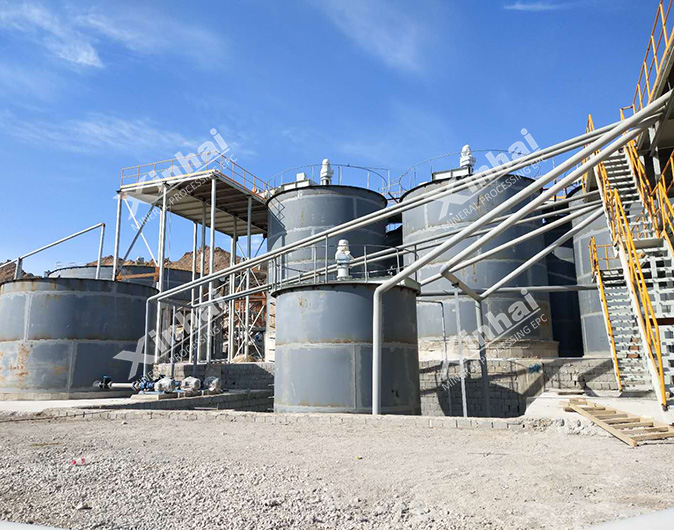cases



The ore type included gold oxidized ore and sulphide ore. The average grade of Au in the oxidized ore was 2.5g/t; The average grade of Au in the suphide ore was 3.39g/t, the average grade of Ag was 40.75g/t.
Crushing and screening system: The crushing system adopted the crushing process with two and half circuits & one closed circuit. ROM was stocked in ROM stock dump. The ROM was fed to ROM bin. The chute feeder was mounted at the bottom of the ROM bin, it fed ROM to jaw crusher for primary crushing. Belt conveyor fed the output of jaw crusher to double-deck circular vibrating screen, materials above the screen was fed to the fine grinding jaw crusher for secondary crushing. The discharged material from fine crushing and upper sieve of the vibrating screen returned to cone crusher by belt conveyor for fine crushing, the discharge was fed to the circular vibrating screen by conveyor, this constitute the closed-circuit system. The lower sieve discharge of the vibrating screen returned to the ore fines bin for storage. After the two and half circuits & one closed circuit, the ore size of the product was -15mm.
Grinding and floatation system: It adapted two stages close grinding system for the oxidized ore. (the fineness was 85-90% at -200 mesh). There was another ball mill for the sulphide ore grinding in the future (the fineness was 90%, -325mesh). The pendulum feeder was mounted at the bottom of powder ore bin, it fed ROM to ball mill by belt conveyor for grinding. The drum screen was set on the discharging of the ball mill, the undersize pulp was classified by the slurry pump & hydrocyclone, then the underflow of the hydrocyclone returned back to the ball mill or re-grinding, this constitute the one-stage circuit system. The overflow of the first-stage hydrocyclone was conveyed by the slurry pump to the second –stage hydrocyclone for second-stage classification. The overflow of the second-stage hydrocyclone entered into the cyanidation leaching operation, the underflow of the second-stage entered into overflow ball mill for re-grinding, the discharge was again fed to second-stage hydrocyclone through the slurry pump for classification, this constituted the two-stage grinding & classification circuit system. Alkali pretreatment system: The overflow of the hydro cyclone went to the wood chip screen and then went to thickener for thickening, then went to double impeller leaching tanks for Alkali pretreatment, the treatment time was 24 hours. Leaching & washing system: The leaching process happened in double impeller leaching tanks, the oxidized ore leaching time was 32 hours, and the sulphide ore leaching time was 24 hours. After that, the slurry went to high efficiency agitation tank until the density reached to 16% then the slurry was pumped to hydraulic transmission high efficiency thickener for the first stage washing, the overflow was pregnant solution; the underflow flew into high efficiency agitation tank until the density reached to 16%, the slurry was pumped to hydralic transmission high efficiency thickener for the second stage washing, and the underflow went to tailings dry system. The overflow of thickener was pregnant solution.
Zinc powder change system: The overflow of the thickener before the alkali pre-treatment went to pregnant solution pond, after filtering and replacement, the gold & silver mud were got. The pregnant solution was pumped into purification filter press through centrifugal pump for purification, in this way the impurity of pregnant can be purified completely to avoid the later replacement reaction. The purified pregnant was pumped into the de-oxygen tower for de-oxygen. If the oxygen was in the pregnant, zinc can react with water & oxygen in the cyaniding liquid, at the same time gold & silver can be dissolved because of the oxygen. In order to reduce the zinc consumption and the dissolution of gold & silver, oxygen in the liquid was removed before adding zinc for gold & silver sediment. The pregnant solution without oxygen was mixed up with zinc powder, and they were pumped into the filter press for replacement, the barren liquor after replacement returned to recycled water tank for slurry mixing, and mud was smelted to get gold & silver ingot.
Dry stacking of tailings: Dry stacking of tailings adopted two parts operation: the tailing filter-pressing + tailing back washing. The underflow of the third stage washing thickener was pumped into tailing buffer tank for buffering, at the same time chemical was added for sediment o the bad ion in the tailing. The slurry after the buffering was pumped into filter press for dehydration. The straining chamber of the filter press and re-washing tank form circulation through pump, the tailing was re-washed after filtering, and re-washing liquid became portion of barren liquor, which was pumped into the middling liquid bath for the water balance in the regulating system. The water content of tailings after the filter press dehydration was ≤18%.
Finally, the purity of gold was higher than 99.5%, the purity of silver ingot was higher than 99.5%.
To find out more about our products and solutions, please fill out the form below and one of our experts will get back to you shortly.